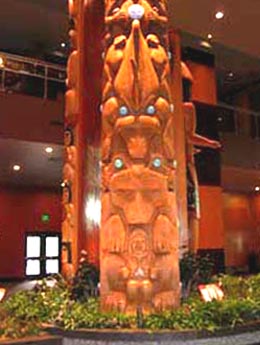On August 15, 2013, the Schack Art Center in Everett honors James Madison (b. 1973), Snohomish County's "Artist of the Year." Madison, a member of the Tulalip Tribes, is feted with a reception and a gallery showing of his work. He was named "Artist of the Year" in February 2013 at the Schack Center's annual H'Arts fundraiser. The Everett Cultural Commission, The Boeing Company, the Washington State Arts Commission, and the National Endowment for the Arts sponsor the August reception in his honor.
An Evening at the Schack
The Snohomish County Artist of the Year award was first given in 1992 by the Arts Council of Snohomish County, which was established in 1975. The council changed its name to the Schack Art Center in 2011 when it opened a gallery in a new building at 2921 Hoyt Avenue in Everett. The center was named for John (1909-2004) and Idamae (b. 1918) Schack, longtime supporters of arts and culture in Snohomish County.
James Madison -- a member of the Snohomish County Arts Council and an arts consultant to the Tulalip Tribes -- was officially recognized as Artist of the Year at the Schack Center's H'Arts fundraiser held at Everett's Comcast Arena on February 23, 2013. On the evening of August 15, 2013, a large crowd attended a reception at the center that honored him for that award and opened a month-long gallery showing of his work. The artist's solo show reflected the wide range of art that he had created over the past decade. Madison was accompanied by his wife and two sons, relatives, friends, and a group of Tulalip drummers.
Traditional Roots
Tulalip Tribes member James Russell Madison was born December 7, 1973, into a family steeped in traditional Salish and Tlingit Northwest-coast Native art. He began carving when he was 8 years old, his first lessons learned from his grandfather Frank Madison (1923-2002). An uncle, Steve Madison, was also an early teacher, and James learned abstract painting and sculpting from his father, Richard Madison (b. 1952).
Following graduation from Everett High School in 1992, James Madison went on to study art at the University of Washington, receiving a bachelor's degree in fine arts in 2000, followed by a bachelor's degree from the Pratt School of Fine Arts in 2004. His studies included courses in Native American Northwest-coast art history; Northwest-coast two-dimensional design and carving; metal sculpture; and glass blowing, fusing, and casting.
Bringing It All Together
While James Madison is a master wood carver, he also works in a variety of contemporary media, including glass, bronze, and stainless steel, and seeks to combine the new with the old. He described his method as trying to "create art with an open mind in the sense that I am always thinking of new ways to add a modern twist to a traditional piece. This allows for me to help to keep my culture alive. As we move into the future, so do the teachings of my ancestors" (Madison website).
One of Madison's major works is a 24-foot story pole in the hotel lobby at the Tulalip Resort and Casino. His artwork can also be seen at Tulalip's Hibulb Cultural Center, the Tulalip Health Clinic, Cabela's at the Tulalip Mall, Lighthouse Park in Mukilteo, Kayak Point Regional Park, Providence Hospital in Everett, and the Burke Museum on the University of Washington campus. Pieces by Madison can be found in downtown Everett; Stanwood; Marysville; Shoreline; Whistler, British Columbia; and New York City. His work has been displayed at the Stonington, Steinbrueck, and Legacy galleries in Seattle.

